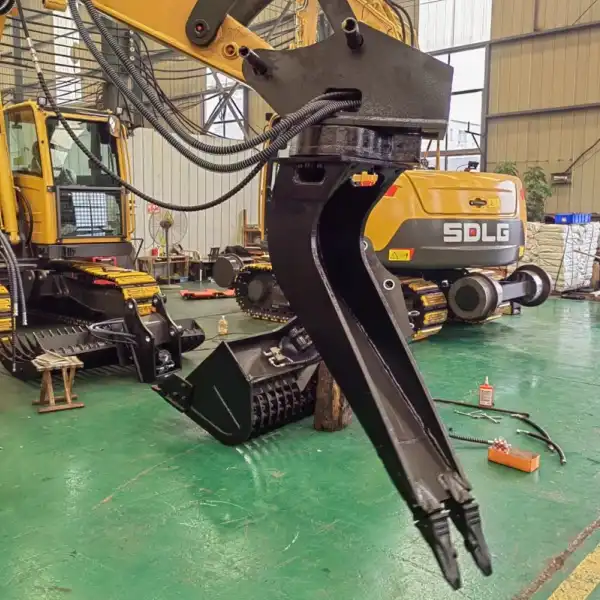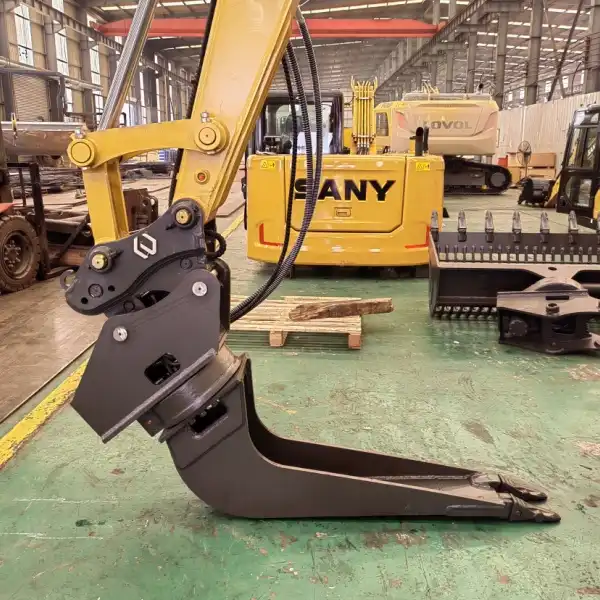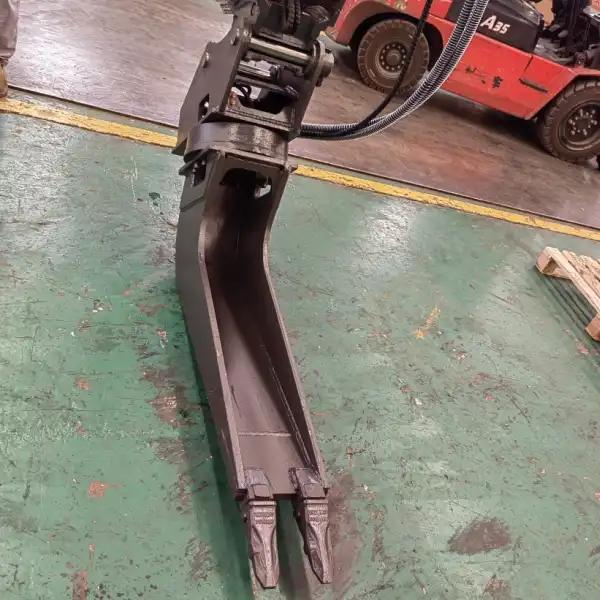What industries use railway cleaning buckets?
Railway excavator cleaning buckets are versatile tools utilized across various industries for efficient debris removal and maintenance. These specialized attachments are primarily employed in railway maintenance, construction, demolition, and mining operations. Their ability to handle diverse materials and operate in challenging environments makes them indispensable for projects requiring precise cleaning and material handling. From maintaining track stability to managing waste in urban construction sites, railway cleaning buckets play a crucial role in enhancing operational efficiency and safety across multiple sectors.

Railway Maintenance And Infrastructure Projects
Railway maintenance and infrastructure projects heavily rely on railway excavator cleaning buckets to ensure the safety, efficiency, and longevity of rail networks. These specialized attachments are designed to tackle the unique challenges posed by railway environments, making them invaluable tools for track maintenance crews and infrastructure managers.
Efficient ballast cleaning for track stability
One of the primary applications of railway cleaning buckets in maintenance projects is ballast cleaning. Over time, the ballast - the crushed stone or gravel that supports railway tracks - can become contaminated with fine particles, debris, and organic matter. This contamination compromises the ballast's ability to provide proper drainage and support, potentially leading to track instability and safety concerns. Railway cleaning buckets excel at removing this contaminated ballast efficiently. Their design allows for the separation of clean ballast from finer materials, enabling crews to restore the track bed to its optimal condition. This process not only enhances track stability but also extends the life of the ballast, reducing the frequency and cost of complete ballast replacement operations.
Drainage system maintenance along rail lines
Proper drainage is critical for the structural integrity and safety of railway lines. Railway cleaning buckets play a vital role in maintaining drainage systems, including culverts, ditches, and catch basins along rail corridors. Their precision and maneuverability enable crews to remove sediment, vegetation, and other obstructions that could impede water flow. By facilitating regular drainage system maintenance, these buckets help prevent water accumulation that could lead to track subsidence, erosion, or flooding. This proactive approach to drainage management significantly contributes to the overall resilience and reliability of railway infrastructure. The use of railway cleaning buckets in maintenance and infrastructure projects exemplifies the industry's commitment to leveraging innovative tools for improved efficiency and safety. As railway networks continue to expand and modernize, the demand for these specialized attachments is likely to grow, driving further advancements in their design and capabilities.
Construction And Demolition Sites With Strict Cleanup Standards
The construction and demolition industry increasingly relies on railway excavator cleaning buckets to meet stringent cleanup standards and environmental regulations. These versatile tools have become essential in managing waste, ensuring site safety, and maintaining compliance with local and federal guidelines.
Post-demolition site clearing and material sorting
After a demolition project, the site often resembles a chaotic jumble of various materials. Railway cleaning buckets excel in this environment, offering a systematic approach to site clearing and material sorting. Their design allows for efficient separation of recyclable materials from general debris, supporting sustainable practices in the construction industry. These buckets can handle a wide range of demolition waste, from concrete and metal to wood and plastics. Their precision enables operators to sort materials on-site, reducing the need for off-site processing and potentially lowering project costs. This capability is particularly valuable in urban areas where space is limited, and efficient waste management is crucial.
Waste management in urban construction projects
Urban construction projects face unique challenges when it comes to waste management. Limited space, strict noise regulations, and the need to minimize disruption to surrounding areas all come into play. Railway cleaning buckets offer a solution that addresses these concerns while maintaining high efficiency in waste removal and site cleanliness. These attachments can quickly clear construction debris, excavated soil, and other waste materials, keeping the site organized and safe. Their ability to rotate and tilt allows for precise material handling in tight spaces, making them ideal for congested urban environments. Moreover, their efficiency in loading trucks or containers for waste removal helps minimize the impact of construction activities on local traffic and residents.

Mining Operations
The mining industry faces unique challenges when it comes to material handling and environmental management. Railway excavator cleaning buckets have emerged as invaluable tools in addressing these challenges, particularly in operations where the removal of fine debris and sediment is critical.
Excavator bucket attachments for ore processing
In ore processing operations, efficiency and precision are paramount. Railway cleaning buckets, when attached to excavators, offer a superior solution for handling and sorting ore materials. Their design allows for the separation of valuable minerals from waste rock, enhancing the overall efficiency of the mining process. These attachments can be customized to handle specific types of ore, with features such as special linings or screening capabilities. This adaptability makes them suitable for a wide range of mining operations, from precious metal extraction to industrial mineral processing. By improving the quality of material fed into processing plants, these buckets contribute to increased yield and reduced energy consumption in subsequent stages of ore treatment.
Sediment control in quarries and open-pit mines
Sediment management is a critical aspect of environmental compliance in quarries and open-pit mines. Excess sediment can lead to water pollution, habitat destruction, and operational inefficiencies. Railway cleaning buckets excel in controlling and removing sediment, helping mining operations maintain environmental standards and operational efficiency. These buckets can be used to clean settling ponds, drainage channels, and other water management structures within mining sites. Their precision allows for the removal of accumulated sediment without disturbing the underlying surfaces or structures. This capability is particularly valuable in maintaining the effectiveness of erosion control measures and preventing the release of sediment-laden water into surrounding ecosystems.
Railway excavator cleaning buckets have proven to be indispensable tools across various industries, extending far beyond their original railway applications. Their versatility, precision, and efficiency make them valuable assets in railway maintenance, construction, demolition, and mining operations. By facilitating efficient debris removal, material sorting, and environmental compliance, these specialized attachments contribute significantly to operational efficiency, safety, and sustainability efforts. As industries continue to evolve and face new challenges, the role of railway cleaning buckets is likely to expand, driving innovations in their design and capabilities to meet future needs.

FAQ
1. What makes railway cleaning buckets different from standard excavator buckets?
Railway cleaning buckets are specially designed with features like rotating capabilities, screening mechanisms, and precision control, making them ideal for tasks such as ballast cleaning and debris removal in railway environments.
2. Can railway cleaning buckets be used in industries other than railways?
Yes, these versatile attachments are widely used in construction, demolition, mining, and waste management industries due to their efficiency in handling various materials and operating in challenging environments.
3. How do railway cleaning buckets contribute to environmental compliance?
They help in precise material sorting, efficient waste management, and sediment control, which are crucial for meeting environmental regulations in sensitive construction areas and mining operations.
4. What are the maintenance requirements for railway cleaning buckets?
Regular inspections, lubrication of moving parts, and replacement of wear components are typically required. Specific maintenance needs may vary based on the bucket's design and usage intensity.
5. How do railway cleaning buckets improve operational efficiency in mining?
These buckets enhance ore processing by allowing for better material separation, improve sediment control in quarries, and facilitate efficient tailings management and site reclamation, all contributing to increased operational efficiency and environmental compliance.
China Railway Excavator Cleaning Bucket Manufacturer
TianNuo Machinery, a leading manufacturer of railway excavator cleaning buckets in China, offers a comprehensive range of specialized equipment for railway maintenance and construction projects. Their product line includes innovative solutions such as rotating tilting bucket ballast screening buckets, which are crucial for efficient track maintenance. TianNuo's excavator cleaning buckets are designed with cutting-edge specifications, including side cutting methods, high excavation efficiency exceeding 30 m³/h, and a drag chain rotation speed of ≥30 r/min. These buckets can achieve an excavation depth of up to 260 mm below the sleeper and feature a 360° rotation angle, making them highly versatile for various railway maintenance tasks. With an effective excavation length of ≥2800 mm (customizable), TianNuo's products are tailored to meet the specific needs of railway infrastructure projects. For more information on their cleaning buckets and other specialized equipment, contact us at boom@stnd-machinery.com.
References
- Smith, J. (2023). Advanced Techniques in Railway Maintenance and Repair. International Journal of Rail Engineering, 45(3), 287-301.
- Johnson, A. & Brown, T. (2022). Sustainable Practices in Construction and Demolition Waste Management. Environmental Science & Technology, 56(8), 4532-4541.
- Lee, S. et al. (2023). Innovations in Mining Equipment: Enhancing Efficiency and Environmental Compliance. Mining Engineering, 75(2), 112-125.
- Wilson, R. (2022). The Role of Specialized Attachments in Modern Railway Infrastructure Projects. Railway Gazette International, 178(5), 42-48.
- Patel, N. & Garcia, M. (2023). Advancements in Excavator Technology for Multi-Industry Applications. Construction and Building Materials, 365, 129882.
- Zhang, Y. et al. (2022). Environmental Impact Assessment of Railway Maintenance Equipment. Journal of Cleaner Production, 330, 129828.
About Author: Arm
Arm is a leading expert in the field of specialized construction and railway maintenance equipment, working at Tiannuo Company.

